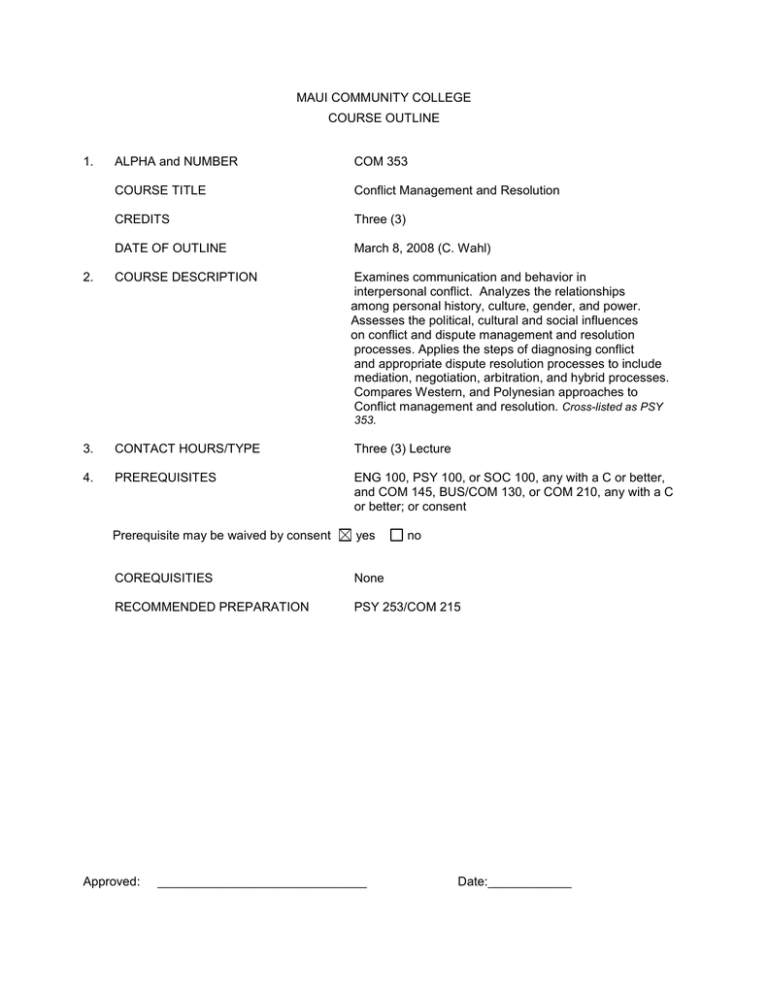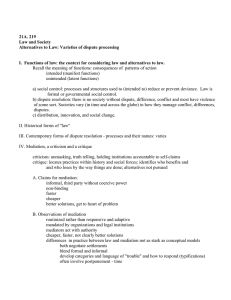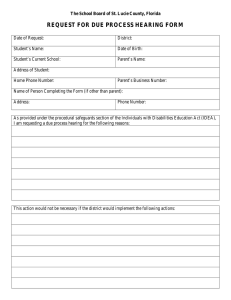
MAUI COMMUNITY COLLEGE
COURSE OUTLINE
1.
2.
ALPHA and NUMBER
COM 353
COURSE TITLE
Conflict Management and Resolution
CREDITS
Three (3)
DATE OF OUTLINE
March 8, 2008 (C. Wahl)
COURSE DESCRIPTION
Examines communication and behavior in
interpersonal conflict. Analyzes the relationships
among personal history, culture, gender, and power.
Assesses the political, cultural and social influences
on conflict and dispute management and resolution
processes. Applies the steps of diagnosing conflict
and appropriate dispute resolution processes to include
mediation, negotiation, arbitration, and hybrid processes.
Compares Western, and Polynesian approaches to
Conflict management and resolution. Cross-listed as PSY
353.
3.
CONTACT HOURS/TYPE
Three (3) Lecture
4.
PREREQUISITES
ENG 100, PSY 100, or SOC 100, any with a C or better,
and COM 145, BUS/COM 130, or COM 210, any with a C
or better; or consent
Prerequisite may be waived by consent
yes
COREQUISITIES
None
RECOMMENDED PREPARATION
PSY 253/COM 215
Approved:
______________________________
no
Date:____________
5.
GENERAL COURSE OBJECTIVES
This course is designed to provide students with an in-depth and focused understanding of
interpersonal conflict as it relates to both personal and professional situations. Through the
examination of the social, cultural, and political influences on conflict and conflict management
and resolution, students assess the issues that arise between individuals, groups and within
organizations, and identify the stages of conflict, and how needs, interests, values, beliefs,
trust and power influence the complexity of a dispute. The course examines the variety
of conflict management and resolution methodologies available, and builds on the
students’ college-level written and oral communication skills so they are able to negotiate
interpersonal differences, engage in effective working relationships, and work well in
teams, including those of diverse compostion. The course explores the ethical considerations of
conflict managers and conflict resolution practitioners, and through the practical use of conflict
diagnostic tools, students are able to prescribe the appropriate conflict management or dispute
resolution process. The course objectives will be met through reading, lecture, writing, role
playing, videos, Power Point presentations, guest speakers, and other applicable exercises and
instructional resources.
See the attached curricular grid for detailed information on how PSY/COM 353 focuses on the
Maui Community College general education standards.
COM 353 fulfills a general education requirement in Maui Community College’s AA (two year) and
BA (four year) degree.
6. Student Learning Outcomes
For assessment, link these to #7. Recommended Course Content, and #9. Recommended Course
Requirements & Evaluation
On successful completion of this course, students will be able to:
a. identify and apply constructive communication skills to manage and resolve conflict;
b. recognize and demonstrate behaviors conducive to cooperative conflict management and
resolution;
c. connect and explain the relationships between personal history, culture, gender, and power
in interpersonal conflict;
d. recognize the social, political, and cultural influences on conflict, conflict management and
resolution;
e. analyze and describe conflict components, and then apply appropriate resolution processes
to conflict in personal and professional contexts;
f. develop and demonstrate conflict management and resolution skills to enhance
interpersonal relationships;
g. examine and demonstrate skills, knowledge, and ethical considerations in the areas of
mediation, negotiation, arbitration and hybrid processes;
h. compare and contrast areas of Western and Polynesian conflict management and resolution
processes.
7. RECOMMENDED COURSE CONTENT AND APPROXIMATE TIME SPENT on EACH TOPIC
Link to #6. Student Learning Outcomes
Week 1
Introduction to Interpersonal Conflict & Dispute Resolution Processes (a, b, c,
d)
Week 2
Preconceptions about Conflict (a, b, c, d, e)
Week 3
Introduction to Conflict Diagnosis & Recurrent Themes (a, b, c, d, e, f, g)
Week 4
Describing the Conflict (a, b, c, d, e, f)
Week 5
Identifying Sources of Conflict (a, b, c, d, e, f)
Week 6
Interest Analysis (a, b, c, f, g)
Week 7
Assess the Character of the Conflict as Constructive or Destructive (a, b, c, d,
e, g)
Week 8
Assess the Levels of Trust and Develop Strategies to Increase or Preserve It
& Impediments to Resolving the Conflict (a, b, c, e, f, g)
Week 9
Assess the Negotiation Styles and Practices of the Participants & Assess
Power and Alternatives to a Negotiated Agreement (a, b, c, d, e, f, g)
Week 10
Diversity Issues at Play in the Conflict (a, b, c, d, e, f)
Week 11
The Process of Mediation (a, b, e, f, g, h)
Week 12
Advantages and Disadvantages to Mediation (d, e, f, g, h)
Week 13
Arbitration (e, f, g)
Week 14
Hooponopono, Restorative Justice & Hybrid Dispute Resolution Processes (a,
b, c, d, e, f, g, h)
Week 15
Group Presentations (c, d, e)
The exact content and arrangement of the content, and the time allotted for content will be
determined by the instructor at the time the course is offered.
8.
TEXT AND MATERIALS
An appropriate text(s) and materials will be chosen at the time the course is to be offered from
the texts and materials that are available at the time in the field. Examples of currently available
texts and materials include:
Required Text:
Coltri, Laurie S. Conflict Diagnosis and Alternative Dispute Resolution
Upper Saddle River, NJ: Pearson Prentice Hall, 2004
Materials:
Handouts developed by the instructor, from journals and other media, and from sources listed
under Other below.
Other:
Reference Materials, including books, such as: Isaacs, William. Dialog and the Art of Thinking
Together: A Pioneering Approach to Communicating In Business and in Life New York, NY:
Doubleday, 1999 Getting to Yes: Negotiating Agreements without Giving In by Roger Fisher and
William Ury; Conflict From Theory To Action by Roxane S. Lulofs and Dudley D. Cahn;
Controlling Conflict by Edward J. Costello, Jr.; The Conflict and Communication Activity Book by
Bill Withers and Keami D. Lewis
.
Websites such as: Conflict Resolution Resource Center at: http://www.conflict-resolution.net/,
and websites that contain information and articles about the Hawaiian Conflict Resolution
method of Hooponopono http://www.hooponopono.org,
http://www.hooponopono.org/Articles/articles.htm and information and articles about Restorative
Justice Programs originating in New Zealand http://www.aic.gov.au/crc/reports/strang/intro.html
Community mediation organizations, such as: Mediation Services of Maui, Inc.; Mediation
Center of Molokai, Inc; Mediation Centers of Hawaii, Inc.
Other appropriate materials such as videos, guest speakers, practicum work, field trips, etc.
9.
RECOMMENDED COURSE REQUIREMENTS and EVALUATION
Link to #6. Student Learning Outcomes
Specific course requirements are at the discretion of the instructor at the time the course is
being offered. Suggested requirements might include, but are not limited to:
Simulated mediations and negotiations,
role plays, demonstrations,
group work, exercises* (a-h)
50% to 80%
Oral and/or written exams,
quizzes (a-h)
20% to 50%
Projects or research (written reports
and/or class presentations) (a-h)
20% to 40%
Assignments (discussion logs, journals, research
Papers) (a-h)
0% to 20%
Class attendance, participation (a-h)
0% to 20%.
Service Learning, Practicum, Internships
activities with community mediation
organizations such as Mediation Services
of Maui, Inc. (a-h)
0% to 20%.
Not to exceed
100% of grade
These percentages set a minimum and maximum for areas to be, or that may be, evaluated in
the course. A faculty member in his/her syllabus would plan the evaluation of the course within
these parameters to suit- the method and number of presentations, his/her own teaching
convictions and/or the needs of the students.
*At least 50% of the final evaluation is to be based on activities that display the student’s conflict
resolution skills, such as simulated negotiation and mediations, practicum work, and
communication activities.
10.
METHODS OF INSTRUCTION
Instructional methods will vary considerably with instructors. Specific methods will be at the
discretion of the instructor teaching the course and might include, but are not limited to:
lecture
group discussion
video-tapes, other audio-visual methods
guest speakers and public lectures
simulations, role play, experiential exercises in dyads, triads, small groups, and large groups
demonstrations, presentations
quizzes, written and/or oral examinations
field trips
projects
practicum work, Service Learning, activities with community based mediation centers, such as
Mediation Services of Maui, Inc.
homework assignments (discussion logs, journals, research papers, other assignments)
other appropriate methods.
ASSESSMENT OF INTENDED STUDENT LEARNING OUTCOMES STANDARDS
Standard 1 - Written Communication
Write effectively to convey ideas that meet the needs of specific audiences and
purposes.
Outcome 1.1 - Use writing to discover and articulate ideas.
COURSE
ALPHA
COM
353
3
Outcome 1.2 - Identify and analyze the audience and purpose for any intended
communication.
2
Outcome 1.3 - Choose language, style, and organization appropriate to particular
purposes and audiences.
2
Outcome 1.4 - Gather information and document sources appropriately.
3
Outcome 1.5 - Express a main idea as a thesis, hypothesis, or other appropriate
statement.
2
Outcome 1.6 - Develop a main idea clearly and concisely with appropriate content.
2
Outcome 1.7 - Demonstrate a mastery of the conventions of writing, including
grammar, spelling, and mechanics.
2
Outcome 1.8 - Demonstrate proficiency in revision and editing.
2
Outcome 1.9 - Develop a personal voice in written communication.
Standard 2 - Quantitative Reasoning
Synthesize and articulate information using appropriate mathematical methods
to solve problems of quantitative reasoning accurately and appropriately.
3
COM
353
Outcome 2.1 - Apply numeric, graphic, and symbolic skills and other forms of
quantitative reasoning accurately and appropriately.
0
Outcome 2.2 - Demonstrate mastery of mathematical concepts, skills, and
applications, using technology when appropriate.
0
Outcome 2.3 - Communicate clearly and concisely the methods and results of
quantitative problem solving.
0
Outcome 2.4 - Formulate and test hypotheses using numerical experimentation.
0
Outcome 2.5 - Define quantitative issues and problems, gather relevant information,
analyze that information, and present results.
0
Outcome 2.6 - Assess the validity of statistical conclusions.
Standard 3 - Information Retrieval and Technology
Access, evaluate, and utilize information effectively, ethically, and responsibly.
0
COM
353
Outcome 3.1 - Use print and electronic information technology ethically and
responsibly.
1
Outcome 3.2 - Demonstrate knowledge of basic vocabulary, concepts, and operations
of information retrieval and technology.
2
Outcome 3.3 - Recognize, identify, and define an information need.
3
Outcome 3.4 - Access and retrieve information through print and electronic media,
evaluating the accuracy and authenticity of that information.
2
Outcome 3.5 - Create, manage, organize, and communicate information through
electronic media.
1
Outcome 3.6 - Recognize changing technologies and make informed choices about
their appropriateness and use.
Standard 4 - Oral Communication
Practice ethical and responsible oral communications appropriately to a variety
of audiences and purposes.
2
COM
353
Outcome 4.1 - Identify and analyze the audience and purpose of any intended
communication.
2
Outcome 4.2 - Gather, evaluate, select, and organize information for the
communication.
3
Outcome 4.3 - Use language, techniques, and strategies appropriate to the audience
and occasion.
3
Outcome 4.4 - Speak clearly and confidently, using the voice, volume, tone, and
articulation appropriate to the audience and occasion.
3
Outcome 4.5 - Summarize, analyze, and evaluate oral communications and ask
coherent questions as needed.
3
Outcome 4.6 - Use competent oral expression to initiate and sustain discussions.
Standard 5 - Critical Thinking
Apply critical thinking skills to effectively address the challenges and solve
problems.
3
COM
353
Outcome 5.1 - Identify and state problems, issues, arguments, and questions
contained in a body of information.
3
Outcome 5.2 - Identify and analyze assumptions and underlying points of view relating
to an issue or problem.
3
Outcome 5.3 - Formulate research questions that require descriptive and explanatory
analyses.
1
Outcome 5.4 - Recognize and understand multiple modes of inquiry, including
investigative methods based on observation and analysis.
2
Outcome 5.5 - Evaluate a problem, distinguishing between relevant and irrelevant
facts, opinions, assumptions, issues, values, and biases through the use of
appropriate evidence.
3
Outcome 5.6 - Apply problem-solving techniques and skills, including the rules of logic
and logical sequence.
3
Outcome 5.7 - Synthesize inform from various sources, drawing appropriate
conclusions.
2
Outcome 5.8 - Communicate clearly and concisely the methods and results of logical
reasoning.
2
Outcome 5.9 - Reflect upon and evaluate their thought processes, value system, and
world views in comparison to those of others.
Standard 6 - Creativity
Program graduates are able to express originality through a variety of forms
.
3



